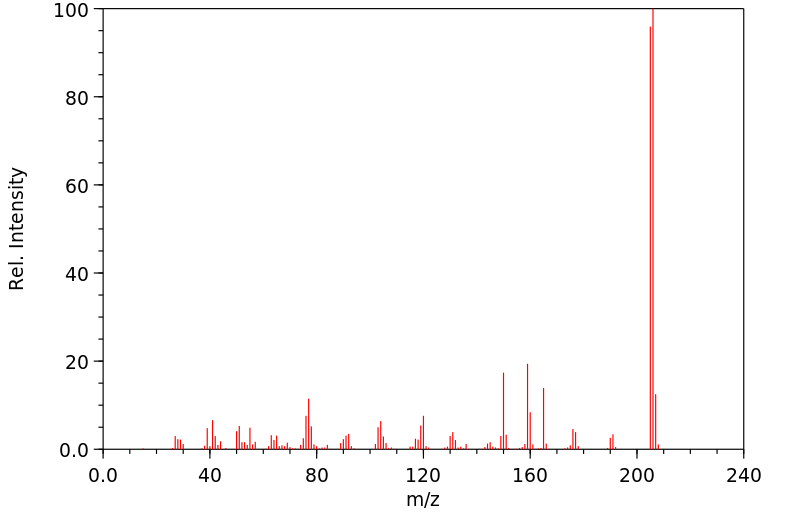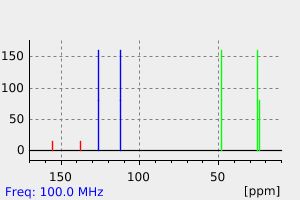1-(4-硝基苯基)哌啶 | 6574-15-8
中文名称
1-(4-硝基苯基)哌啶
中文别名
N-(4-硝基苯)哌啶;1-(4-硝基苯)哌啶
英文名称
1-(4-nitrophenyl)piperidine
英文别名
N-(4-nitrophenyl)piperidine;4-(piperidin-1-yl)-1-nitrobenzene
CAS
6574-15-8
化学式
C11H14N2O2
mdl
MFCD00023662
分子量
206.244
InChiKey
SGPLAXFUDTWHRS-UHFFFAOYSA-N
BEILSTEIN
——
EINECS
——
-
物化性质
-
计算性质
-
ADMET
-
安全信息
-
SDS
-
制备方法与用途
-
上下游信息
-
文献信息
-
表征谱图
-
同类化合物
-
相关功能分类
-
相关结构分类
物化性质
-
熔点:104-106°C
-
沸点:363.5±25.0 °C(Predicted)
-
密度:1.188±0.06 g/cm3(Predicted)
-
溶解度:19.9 [ug/mL]
计算性质
-
辛醇/水分配系数(LogP):3.3
-
重原子数:15
-
可旋转键数:1
-
环数:2.0
-
sp3杂化的碳原子比例:0.454
-
拓扑面积:49.1
-
氢给体数:0
-
氢受体数:3
安全信息
-
危险品标志:Xi
-
安全说明:S22,S36
-
危险类别码:R36/37/38
-
海关编码:2933399090
-
危险性防范说明:P261,P305+P351+P338
-
危险性描述:H315,H319,H335
-
储存条件:| 2-8°C |
SDS
| Name: | 1-(4-Nitrophenyl)piperidine 97% Material Safety Data Sheet |
| Synonym: | |
| CAS: | 6574-15-8 |
Synonym:
Section 2 - COMPOSITION, INFORMATION ON INGREDIENTS
| CAS# | Chemical Name | content | EINECS# |
| 6574-15-8 | 1-(4-Nitrophenyl)piperidine | 97% | 229-492-7 |
Risk Phrases: 36/37/38
Section 3 - HAZARDS IDENTIFICATION
EMERGENCY OVERVIEW
Irritating to eyes, respiratory system and skin.
Potential Health Effects
Eye:
Causes eye irritation.
Skin:
Causes skin irritation. May be harmful if absorbed through the skin.
Ingestion:
May cause irritation of the digestive tract. May be harmful if swallowed.
Inhalation:
Causes respiratory tract irritation. May be harmful if inhaled.
Chronic:
Not available.
Section 4 - FIRST AID MEASURES
Eyes: Flush eyes with plenty of water for at least 15 minutes, occasionally lifting the upper and lower eyelids. Get medical aid.
Skin:
Get medical aid. Flush skin with plenty of water for at least 15 minutes while removing contaminated clothing and shoes.
Ingestion:
Get medical aid. Wash mouth out with water.
Inhalation:
Remove from exposure and move to fresh air immediately. If not breathing, give artificial respiration. If breathing is difficult, give oxygen. Get medical aid.
Notes to Physician:
Treat symptomatically and supportively.
Section 5 - FIRE FIGHTING MEASURES
General Information:
As in any fire, wear a self-contained breathing apparatus in pressure-demand, MSHA/NIOSH (approved or equivalent), and full protective gear.
Extinguishing Media:
Use water spray, dry chemical, carbon dioxide, or chemical foam.
Section 6 - ACCIDENTAL RELEASE MEASURES
General Information: Use proper personal protective equipment as indicated in Section 8.
Spills/Leaks:
Vacuum or sweep up material and place into a suitable disposal container.
Section 7 - HANDLING and STORAGE
Handling:
Avoid breathing dust, vapor, mist, or gas. Avoid contact with skin and eyes.
Storage:
Store in a cool, dry place. Store in a tightly closed container.
Section 8 - EXPOSURE CONTROLS, PERSONAL PROTECTION
Engineering Controls:
Facilities storing or utilizing this material should be equipped with an eyewash facility and a safety shower. Use adequate ventilation to keep airborne concentrations low.
Exposure Limits CAS# 6574-15-8: Personal Protective Equipment Eyes: Not available.
Skin:
Wear appropriate protective gloves to prevent skin exposure.
Clothing:
Wear appropriate protective clothing to prevent skin exposure.
Respirators:
Follow the OSHA respirator regulations found in 29 CFR 1910.134 or European Standard EN 149. Use a NIOSH/MSHA or European Standard EN 149 approved respirator if exposure limits are exceeded or if irritation or other symptoms are experienced.
Section 9 - PHYSICAL AND CHEMICAL PROPERTIES
Physical State: Solid
Color: yellow
Odor: Not available.
pH: Not available.
Vapor Pressure: Not available.
Viscosity: Not available.
Boiling Point: Not available.
Freezing/Melting Point: 104 - 106 deg C
Autoignition Temperature: Not available.
Flash Point: Not available.
Explosion Limits, lower: Not available.
Explosion Limits, upper: Not available.
Decomposition Temperature:
Solubility in water:
Specific Gravity/Density:
Molecular Formula: C11H14N2O2
Molecular Weight: 206
Section 10 - STABILITY AND REACTIVITY
Chemical Stability:
Not available.
Conditions to Avoid:
Incompatible materials.
Incompatibilities with Other Materials:
Oxidizing agents.
Hazardous Decomposition Products:
Nitrogen oxides, carbon monoxide, carbon dioxide.
Hazardous Polymerization: Has not been reported
Section 11 - TOXICOLOGICAL INFORMATION
RTECS#:
CAS# 6574-15-8 unlisted.
LD50/LC50:
Not available.
Carcinogenicity:
1-(4-Nitrophenyl)piperidine - Not listed by ACGIH, IARC, or NTP.
Section 12 - ECOLOGICAL INFORMATION
Section 13 - DISPOSAL CONSIDERATIONS
Dispose of in a manner consistent with federal, state, and local regulations.
Section 14 - TRANSPORT INFORMATION
IATA
No information available.
IMO
No information available.
RID/ADR
No information available.
Section 15 - REGULATORY INFORMATION
European/International Regulations
European Labeling in Accordance with EC Directives
Hazard Symbols: XI
Risk Phrases:
R 36/37/38 Irritating to eyes, respiratory system
and skin.
Safety Phrases:
S 26 In case of contact with eyes, rinse immediately
with plenty of water and seek medical advice.
S 37/39 Wear suitable gloves and eye/face
protection.
WGK (Water Danger/Protection)
CAS# 6574-15-8: No information available.
Canada
None of the chemicals in this product are listed on the DSL/NDSL list.
CAS# 6574-15-8 is not listed on Canada's Ingredient Disclosure List.
US FEDERAL
TSCA
CAS# 6574-15-8 is not listed on the TSCA inventory.
It is for research and development use only.
SECTION 16 - ADDITIONAL INFORMATION
N/A
上下游信息
-
上游原料
中文名称 英文名称 CAS号 化学式 分子量 —— 1-p-nitrophenylpiperidine N-oxide 40832-54-0 C11H14N2O3 222.244 N-苯基哌啶 N-phenyl piperidine 4096-20-2 C11H15N 161.247 —— Methyl 5-[(4-nitrophenyl)amino]-5-oxopentanoate 121409-84-5 C12H14N2O5 266.254 -
下游产品
中文名称 英文名称 CAS号 化学式 分子量 4-羟基-1-(4-硝基苯基)哌啶 1-(4-nitrophenyl)piperidin-4-ol 79421-45-7 C11H14N2O3 222.244 —— 1-p-nitrophenylpiperidine N-oxide 40832-54-0 C11H14N2O3 222.244 1-(4-硝基苯基)-2-哌啶酮 1-(4-nitrophenyl)piperidin-2-one 38560-30-4 C11H12N2O3 220.228 4-(1-哌啶基)苯胺 4-(1-piperidino)aniline 2359-60-6 C11H16N2 176.261 —— N-(4-(piperidin-1-yl)phenyl)formamide 30130-59-7 C12H16N2O 204.272 4-吡咯-1-基-苯胺 4-pyrrolidin-1-yl-aniline 2632-65-7 C10H14N2 162.235 1-(4-异氰酰基苯基)哌啶 4-(piperdin-1-yl)phenyl isocyanate 879896-41-0 C12H14N2O 202.256 —— 1-(4-azidophenyl)piperidine 1393367-48-0 C11H14N4 202.259 —— 1-(4-isothiocyanatophenyl)piperidine 51317-65-8 C12H14N2S 218.323 2-氯-n-(4-哌啶-1-苯基)-乙酰胺 2-chloro-N-(4-(piperidin-1-yl)phenyl)acetamide 379255-22-8 C13H17ClN2O 252.744 1-(2,4-二硝基苯基)哌啶 1-(2,4-dinitrophenyl)piperidine 839-93-0 C11H13N3O4 251.242 N-(4-氨基苯基)-2-哌啶酮 1-(4-aminophenyl)piperidin-2-one 438056-68-9 C11H14N2O 190.245 —— N-(4''-chlorobenzyl)-4-(piperidin-1'-yl)aniline —— C18H21ClN2 300.831 - 1
- 2
反应信息
-
作为反应物:描述:参考文献:名称:XXII.—2'-和4'-硝基-1-苯基哌啶的硝化摘要:DOI:10.1039/jr9300000147
-
作为产物:参考文献:名称:使用硝酸铈(IV)铵在乙腈中对N,N-二烷基苯胺进行区域选择性硝化摘要:的高度选择性和廉价的硝化Ñ,Ñ -dialkylanilines通过在乙腈铈(IV)铵(CAN)室温下,得到p -nitryl- Ñ,Ñ -dialkylanilines以良好产率进行了报道。DOI:10.1016/j.tetlet.2005.10.028
文献信息
-
Borane-Methyl Sulfide Reductive Cyclization of ω-Ester Alkylamides: A Convenient Synthesis of<i>N</i>-Substituted Cyclic Amines作者:Michael C. Venuti、Oswald OrtDOI:10.1055/s-1988-27777日期:——Borane-methyl sulfide (BMS) reduction of variously N-substituted succinamic and glutaramic esters affords the corresponding N-substituted pyrrolidines and piperidines in high yields. The limitations, mainly caused by steric hinderance around the amine nitrogen, and putative intermediates involved in this conversion, as detected by incomplete reaction and/or synthesis followed by BMS reduction, indicate that cyclization and amide reduction successfully compete with ester reduction to afford the N-substituted cyclized amines.
-
Cyclic (Alkyl)(amino)carbene Ligand-Promoted Nitro Deoxygenative Hydroboration with Chromium Catalysis: Scope, Mechanism, and Applications作者:Lixing Zhao、Chenyang Hu、Xuefeng Cong、Gongda Deng、Liu Leo Liu、Meiming Luo、Xiaoming ZengDOI:10.1021/jacs.0c12318日期:2021.1.27Transition metal catalysis that utilizes N-heterocyclic carbenes as noninnocent ligands in promoting transformations has not been well studied. We report here a cyclic (alkyl)(amino)carbene (CAAC) ligand-promoted nitro deoxygenative hydroboration with cost-effective chromium catalysis. Using 1 mol % of CAAC-Cr precatalyst, the addition of HBpin to nitro scaffolds leads to deoxygenation, allowing for利用 N-杂环卡宾作为非无害配体促进转化的过渡金属催化尚未得到很好的研究。我们在这里报告了具有成本效益的铬催化的环状(烷基)(氨基)卡宾(CAAC)配体促进的硝基脱氧硼氢化反应。使用 1 mol % 的 CAAC-Cr 预催化剂,将 HBpin 添加到硝基支架上会导致脱氧,从而保留各种可还原的官能团和敏感基团对硼氢化的相容性,从而提供一种温和、化学选择性和易于形成的策略苯胺,以及杂芳基和脂肪胺衍生物,具有广泛的范围和特别高的转换数(高达 1.8 × 106)。基于理论计算的机械研究,表明CAAC配体在促进HBpin氢化物极性反转中起重要作用;它用作 H 穿梭以促进脱氧硼氢化。通过这种策略制备的几种市售药物突出了其在药物化学中的潜在应用。
-
Reaction of Mono-, Di-, and Trichloronitrobenzenes with<i>N</i>-Methyl Substituted Cyclic Tertiary Amines under High Pressure作者:Toshikazu Ibata、Muhong Shang、Tetsuo DemuraDOI:10.1246/bcsj.68.2717日期:1995.9The reactions of mono-, di-, and trichloronitrobenzenes with 1-methylpyrrolidine under high pressure gave products of demethylation and ring-opening through a quaternary pyrrolidinium chloride intermediate formed by the SNAr reaction. On the other hand, the reactions with 1-methylpiperidine and 4-methylmorpholine gave only demethylation products. The selectivities of the reactions of 1-methylpyrrolidine
-
Solid supported platinum(0) nanoparticles catalyzed chemo-selective reduction of nitroarenes to N-arylhydroxylamines作者:Arun K. Shil、Pralay DasDOI:10.1039/c3gc41179f日期:——reducible functional groups such as halides, carboxylic acids, esters, amides, nitriles, keto, alkenes, alkynes and N-benzyl were well tolerated under the reaction conditions. This process was further successfully employed in 10 g scale reactions. N-Arylhydroxylamines were further applied for catalyst free synthesis of azoxybenzenes. Moreover, use of PEG-400 as cheap reaction medium, additive free methodology
-
Supported Palladium Nanoparticles Catalyzed Reductive Carbonylation of Nitroarenes to <i>N</i> -Arylformamides作者:Vandna Thakur、Ajay Kumar、Nishtha Sharma、Arun K. Shil、Pralay DasDOI:10.1002/adsc.201700944日期:2018.2.1A facile reductive carbonylation reaction of nitroarenes to N‐arylformamide synthesis was investigated under polymer supported palladium (Pd@PS) nanoparticles catalyzed conditions. Dual role of oxalic acid dihydrate ((CO2H)2 ⋅ 2H2O) as H2 source for hydrogenation and CO source for carbonylation reaction for desired products synthesis was critically investigated under favorable DMF solvent conditions
表征谱图
-
氢谱1HNMR
-
质谱MS
-
碳谱13CNMR
-
红外IR
-
拉曼Raman
-
峰位数据
-
峰位匹配
-
表征信息
同类化合物
(R)-3-甲基哌啶盐酸盐;
(R)-2-苄基哌啶-1-羧酸叔丁酯
((3S,4R)-3-氨基-4-羟基哌啶-1-基)(2-(1-(环丙基甲基)-1H-吲哚-2-基)-7-甲氧基-1-甲基-1H-苯并[d]咪唑-5-基)甲酮盐酸盐
高氯酸哌啶
高托品酮肟
马来酸帕罗西汀
颜料红48:4
顺式3-氟哌啶-4-醇盐酸盐
顺式2,6-二甲基哌啶-4-酮
顺式1-苄基-4-甲基-3-甲氨基-哌啶
顺式-叔丁基4-羟基-3-甲基哌啶-1-羧酸酯
顺式-6-甲基-哌啶-1,3-二甲酸1-叔丁酯
顺式-5-(三氟甲基)哌啶-3-羧酸甲酯盐酸盐
顺式-4-叔丁基-2-甲基哌啶
顺式-4-Boc-氨基哌啶-3-甲酸甲酯
顺式-4-(氮杂环丁烷-1-基)-3-氟哌
顺式-3-顺式-4-氨基哌啶
顺式-3-甲氧基-4-氨基哌啶
顺式-3-BOC-3,7-二氮杂双环[4.2.0]辛烷
顺式-3-(1-吡咯烷基)环丁腈
顺式-3,5-哌啶二羧酸
顺式-3,4-二溴-3-甲基吡咯烷盐酸盐
顺式-2,6-二甲基-4-氧代哌啶-1-羧酸叔丁基酯
顺式-1-叔丁氧羰基-4-甲基氨基-3-羟基哌啶
顺式-1-boc-3,4-二氨基哌啶
顺式-1-(4-叔丁基环己基)-4-苯基-4-哌啶腈
顺式-1,3-二甲基-4-乙炔基-6-苯基-3,4-哌啶二醇
顺-4-(4-氟苯基)-1-(4-异丙基环己基)-4-哌啶羧酸
顺-4-(2-氟苯基)-1-(4-异丙基环己基)-4-哌啶羧酸
顺-3-氨基-4-氟哌啶-1-羧酸叔丁酯
顺-1-苄基-4-甲基哌啶-3-氨基酸甲酯盐酸盐
非莫西汀
雷芬那辛
雷拉地尔
阿维巴坦中间体4
阿格列汀杂质
阿尼利定盐酸盐 CII
阿尼利定
阿塔匹酮
阿哌沙班杂质BMS-591455
阿哌沙班杂质87
阿哌沙班杂质52
阿哌沙班杂质51
阿哌沙班杂质5
阿哌沙班杂质
阿哌沙班杂质
阿哌沙班-d3
阿哌沙班
阻聚剂701
间氨基谷氨酰胺








